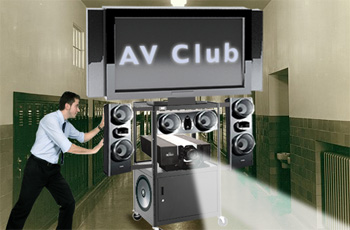3D for Me?
If you watch developments in consumer AV, you’re likely picking up some of the buzz with the latest push toward 3DTV. As such perhaps you’re also starting to give some serious thought to what that may mean to you as an AV consumer, and then, what the impact might be in education applications. So when the AV Club makes its foray into exploring 3D further, it is with great anticipation for a new “techie” (and End User). But it’s also with a fair amount of trepidation.
developments in consumer AV, you’re likely picking up some of the buzz with the latest push toward 3DTV. As such perhaps you’re also starting to give some serious thought to what that may mean to you as an AV consumer, and then, what the impact might be in education applications. So when the AV Club makes its foray into exploring 3D further, it is with great anticipation for a new “techie” (and End User). But it’s also with a fair amount of trepidation.
Why? Well, for many of us, 3D is not exactly a new frontier. Rather it’s a niche application that’s been around for some time. And while cool enough, it has repeatedly failed to inspire a rush of AV spending. And it’s not only the technology, which can look undeniably impressive, but it’s also a range of nagging issues that have a cumulative effect of stifling larger scale adoption.
Having been exposed to a few scientific/educational 3D setups over the years, there is no doubt to the value of 3D. Heck, if someone can “stand” inside a virtual building (by way of 3D “cave”) before it’s built, or a group of chemistry students can watch as an instructor manipulates a 3D representation of molecule, the experience can be priceless for advancing understanding of complex problems. An end user exposed briefly to these completed AV systems one may be inclined to think, “Where do I sign?” But the price tag is not an insignificant one. If consumer 3D takes hold in any meaningful way, it stands to reason the cost barrier could be mitigated.
Digging deeper, looking into the technical aspects of 3D’s recent history, quickly reveals a quagmire of one-off customizations and/or incompatibilities between 3D content and the systems built to view it. That is to say, one may find specific 3D content (or an application) that is the initial lure into getting a system, only to then find another content source or application is “not supported” by the same hardware. This hurts, especially if you’ve just laid out big bucks for said system. Again, though, there is promise that a new consumer 3DTV standard can move all of us toward a singular standardized format.
And then there are the glasses. Whether passive or active, the best performing technologies require wearing special glasses. Doing so, whether in a public or private forum is fodder for logistical, self-conscious and hygienic hindrances. If broader demand leads to advancements in lenticular/autostereoscopic displays (which are direct view displays that don’t require special glasses), that’d hold some serious promise for consumer buy-in.
Ultimately, though, in comparison to the various legacy challenges 3DTV faces, perhaps the biggest challenge of all is the legacy consumer experience with 3D. In my case, that experience is the awkward aftermath of a highly anticipated attendance of “It’s A Bugs Life 3D” at Disney. The actual “experience” was cut short — to maybe 20 seconds that I actually had the glasses on and was looking in the right direction — by a youngster that became COMPLETELY unglued at first sight of a large “friendly” insect heading straight toward her (of all the people in the auditorium, none the less)! Like everyone else within a half dozen rows, this would have been limited to perhaps a serious annoyance (big money and long waits having been expended)… had the youngster not been mine. In retrospect, I blame myself. Perhaps we should have spent another 30 minutes outside on that bench beforehand discussing how it “might look real, but is just pretend.” No, I’m kidding myself, as I’m now pretty sure my spending that time to tell them what I thought they’d see would have been better spent talking about anything else but virtual 3D bugs. Real bugs we can anticipate, flat virtual (TV) bugs we’re used to, but these 3D things, our brains aren’t so sure what to do with.
As gregthetechie, I’m all for advancing the AV experience and have not much question in my mind that 3D will be in all our futures. It’s just that, as of February 2010, I’m still asking the fundamental question — is 3D for me?
The views expressed in this column do not necessarily reflect the views of the authors’ employer(s), past or present.
Greg Bronson, CTS-D, applies AV technologies in the development of innovative learning spaces for higher education. Greg spent the first 10 years of his career as AV technician and service manager, with the past 12+ years as an AV system designer and project manager. Bronson currently works for Cornell University and has also worked for two SUNY (State University of New York) campuses as well as a regional secondary education service depot. Bronson is the originator of concept for Infocomm’s Dashboard for Controls and has had completed projects featured in industry publications. You can reach Greg at gregthetechie@netscape.net





